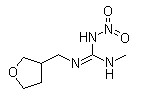Dinotefuran is an antiparasitic active ingredient used in veterinary medicine in dogs and cats against external parasites (fleas, flies, lice, etc.). It is also used against agricultural and household pests. It belongs to the chemical class of the neonicotinoids.
Common name: DINOTEFURAN
Type: Pesticide or veterinary medicine, depending on usage
Chemical class: neonicotinoid
CHEMICAL STRUCTURE

EFFICACY AGAINST PARASITES
Type of action: Contact, non-systemic insecticide
Main veterinary parasites controlled: fleas, houseflies and other nuisance flies
Efficacy against a specific parasite depends on the delivery form and on the dose administered.
Click here for general information on features and characteristics of PARASITICIDES.
DOSING
Dinotefuran is a contact insecticide without systemic effect that belongs to the chemical class of the neonicotinoids. It is highly effective against fleas but not against ticks or mites, or any internal parasites.
It is often used in combination with a tickicide/acaricide (e.g. permethrin) or with an insect growth regulator (e.g. pyriproxyfen). So far it is not used in livestock or horses.
The table below indicates some usual dosing recommendations for dinotefuran issued by manufacturers or documented in the scientific literature. They may not be approved in some countries.
| Dosing recommendations for DINOTEFURAN |
||
| Delivery | Parasites | Dose (against dinotefuran-susceptible parasites) |
| DOGS | ||
| Spot-on | Fleas | 17.6 - 286 mg/kg, depending on animal's weight |
| CATS | ||
| Spot-on | Fleas | 44.0 - 176 mg/kg, depending on animal's weight |
DISCLAIMER: Liability is denied for any possible damage or harm to persons, animals or any other goods that could follow the transmission or use of the information, data or recommendations in this site by any site visitor or third parties.>
Dosing recommendations for antiparasitics depend on national regulations. National regulatory authorities determine whether a product is approved for a given indication, i.e. use on a particular host at a specific dose and against a specific parasite. Check the labels of the products available in your country for specific information on approved indications.
SAFETY
Oral LD50, rat, acute*: ≥ 2000 mg/kg
Dermal LD50, rat, acute*: >2000 mg/kg
* These values refer to the active ingredient. Toxicity has to be determined for each formulation as well. Formulations are usually significantly less toxic than the active ingredients.
MRL (maximum residue limit): Not applicable: not approved for livestock
Withholding periods for meat, milk, eggs: Not applicable: not approved for livestock
General safety information for antiparasitics is available in specific articles in this site (click to visit):
- General safety of antiparasitics for domestic animals
- General safety of antiparasitics for humans
- General safety of antiparasitics for the environment
|
WARNING Never use agricultural or hygiene products with this or any other active ingredient on livestock or pets, even if there are veterinary products with this same active ingredient approved for use on animals. The formulations for agricultural or hygiene use are different and may be toxic for livestock or pets. It is obvious that veterinary products are not intended for and should never be used on humans!!! |
MARKETING & USAGE
Decade of introduction: 1990
Introduced by: MITSUI
Some original brands: VECTRA, VETRA 3D (ex CEVA, for pets)
Patent: Expired (particular formulations may be still patent-protected)
Use on LIVESTOCK: No
Use on HORSES: NO
Use on DOGS and CATS: Yes, scarcely
Main delivery forms:
Use in human medicine: No
Use in public/domestic hygiene: Yes
Use in agriculture: Yes
Generics available: Yes, a few
PARASITE RESISTANCE
On livestock: reported on houseflies for other neonicotinoids (imidacloprid, thiamethoxam), most probably cross-resistance with dinotefuran.
On pets: No
SPECIFIC FEATURES
Dinotefuran is a neonicotinoid insecticide used on dogs and cats in spot-ons (=pipettes, squeeze-on) for flea control (VECTRA, VECTRA 3D) and in baits for off-animal use against houseflies and other nuisance flies in livestock operations (poultry houses, stables, piggeries, etc.).
It is not effective against ticks, mites or lice. For this reason it is also used in mixtures with other active ingredients that broaden the spectrum of activity.
The fly bait acts mainly as an oral insecticide for flies, i.e. it does not control bloodsucking flies or other insects.
Pharmacokinetics of dinotefuran
After topical administration to dogs and cats dinotefuran remains mostly on the animal's surface and is not absorbed. However a certain amount can be ingested through licking and grooming. In laboratory animals ingested dinotefuran was almost completely absorbed (>90%) quickly distributed throughout the whole body and also rapidly eliminated, mostly through urine in the form of unchanged dinotefuran.
Mechanism of action of dinotefuran
As all neonicotinoids dinotefuran is an agonists of the nicotinic acetylcholine receptors. It takes the place of the normal neurotransmitter acetylcholine in the receptors, which cannot be deactivated by acetylcholinesterase and remains irreversibly blocked. This leads to an over stimulation of the nerve cells, to paralysis and to death of the affected insect.
These receptors are found in the central and peripheral nervous system of mammals, but only in the central nervous systems of insects. Neonicotinoids bind much more strongly to insect receptors than to mammal receptors, which makes them relatively safe for domestic animals and humans.
Click here to view the list of all technical summaries of antiparasitic active ingredients in this site.